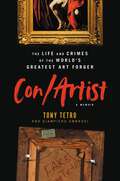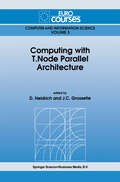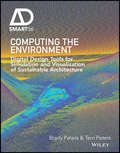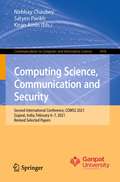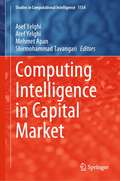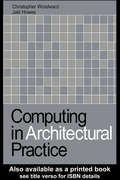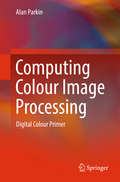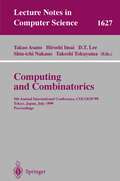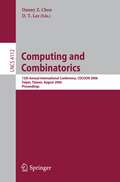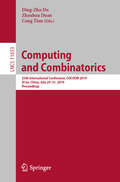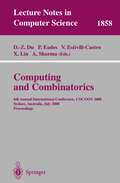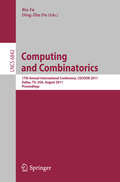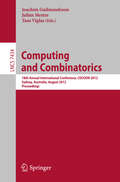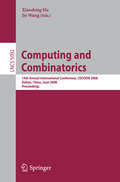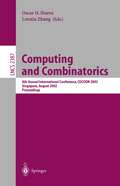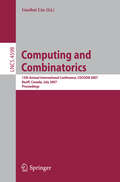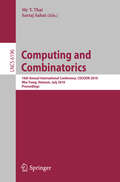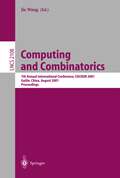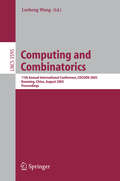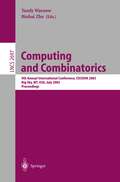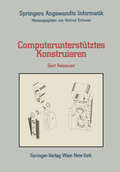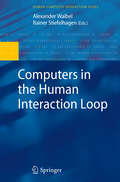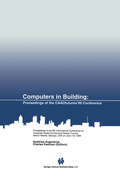- Table View
- List View
Con/Artist: The Life and Crimes of the World's Greatest Art Forger
by Tony Tetro Giampiero AmbrosiThe world&’s most renowned art forger reveals the secrets behind his decades of painting like the masters—exposing an art world that is far more corrupt than we ever knew while providing an art history lesson wrapped in sex, drugs, and Caravaggio. The art world is a much dirtier, nastier business than you might expect. Tony Tetro, one of the most renowned art forgers in history, will make you question every masterpiece you&’ve ever seen in a museum, gallery, or private collection. Tetro&’s &“Rembrandts,&” &“Caravaggios,&” &“Miros,&” and hundreds of other works now hang on walls around the globe. In 2019, it was revealed that Prince Charles received into his collection a Picasso, Dali, Monet, and Chagall, insuring them for over 200 million pounds, only to later discover that they&’re actually &“Tetros.&” And the kicker? In Tony&’s words: &“Even if some tycoon finds out his Rembrandt is a fake, what&’s he going to do, turn it in? Now his Rembrandt just became motel art. Better to keep quiet and pass it on to the next guy. It&’s the way things work for guys like me.&” The Prince Charles scandal is the subject of a forthcoming feature documentary with Academy Award nominee Kief Davidson and coauthor Giampiero Ambrosi, in cooperation with Tetro. Throughout Tetro&’s career, his inimitable talent has been coupled with a reckless penchant for drugs, fast cars, and sleeping with other con artists. He was busted in 1989 and spent four years in court and one in prison. His voice—rough, wry, deeply authentic—is nothing like the high society he swanned around in, driving his Lamborghini or Ferrari, hobnobbing with aristocrats by day, and diving into debauchery when the lights went out. He&’s a former furniture store clerk who can walk around in Caravaggio&’s shoes, become Picasso or Monet, with an encyclopedic understanding of their paint, their canvases, their vision. For years, he hid it all in an unassuming California townhouse with a secret art room behind a full-length mirror. (Press #* on his phone and the mirror pops open.) Pairing up with coauthor Ambrosi, one of the investigative journalists who uncovered the 2019 scandal, Tetro unveils the art world in an epic, alluring, at times unbelievable, but all-true narrative.
Computing with T.Node Parallel Architecture (Eurocourses: Computer and Information Science #3)
by D. Heidrich J. C. GrossetieParallel processing is seen today as the means to improve the power of computing facilities by breaking the Von Neumann bottleneck of conventional sequential computer architectures. By defining appropriate parallel computation models definite advantages can be obtained. Parallel processing is the center of the research in Europe in the field of Information Processing Systems so the CEC has funded the ESPRIT Supemode project to develop a low cost, high performance, multiprocessor machine. The result of this project is a modular, reconfigurable architecture based on !NMOS transputers: T.Node. This machine can be considered as a research, industrial and commercial success. The CEC has decided to continue to encourage manufacturers as well as research and end-users of transputers by funding other projects in this field. This book presents course papers of the Eurocourse given at the Joint Research Centre in ISPRA (Italy) from the 4th to 8 of November 1991. First we present an overview of various trends in the design of parallel architectures and specially of the T.Node with it's software development environments, new distributed system aspects and also new hardware extensions based on the !NMOS T9000 processor. In a second part, we review some real case applications in the field of image synthesis, image processing, signal processing, terrain modeling, particle physics simulation and also enhanced parallel and distributed numerical methods on T.Node.
Computing the Environment: Digital Design Tools for Simulation and Visualisation of Sustainable Architecture (AD Smart)
by Brady Peters Terri PetersComputing the Environment presents practical workflows and guidance for designers to get feedback on their design using digital design tools on environmental performance. Starting with an extensive state-of-the-art survey of what top international offices are currently using in their design projects, this book presents detailed descriptions of the tools, algorithms, and workflows used and discusses the theories that underlie these methods. Project examples from Transsolar Klimaengineering, Buro Happold´s SMART Group, Behnish Behnisch Architects, Thomas Herzog, Autodesk Research are contextualized with quotes and references to key thinkers in this field such as Eric Winsberg, Andrew Marsh, Michelle Addington and Ali Malkawi.
Computing the Environment: Digital Design Tools for Simulation and Visualisation of Sustainable Architecture (AD Smart)
by Brady Peters Terri PetersComputing the Environment presents practical workflows and guidance for designers to get feedback on their design using digital design tools on environmental performance. Starting with an extensive state-of-the-art survey of what top international offices are currently using in their design projects, this book presents detailed descriptions of the tools, algorithms, and workflows used and discusses the theories that underlie these methods. Project examples from Transsolar Klimaengineering, Buro Happold´s SMART Group, Behnish Behnisch Architects, Thomas Herzog, Autodesk Research are contextualized with quotes and references to key thinkers in this field such as Eric Winsberg, Andrew Marsh, Michelle Addington and Ali Malkawi.
Computing Science, Communication and Security: Second International Conference, COMS2 2021, Gujarat, India, February 6–7, 2021, Revised Selected Papers (Communications in Computer and Information Science #1416)
by Nirbhay Chaubey Satyen Parikh Kiran AminThis book constitutes revised selected papers of the Second International Conference on Computing Science, Communication and Security, COMS2 2021, held in Gandhinagar, India, in February 2021. Due to the COVID-19 pandemic the conference was held virtually. The 19 full papers were thoroughly reveiwed and selected from 105 submissions. Papers are organised according to the topical sections on artificial intelligence and machine learning; networking and communications.
Computing Intelligence in Capital Market (Studies in Computational Intelligence #1154)
by Asef Yelghi Aref Yelghi Mehmet Apan Shirmohammad TavangariThe book is divided into sections according to the content of the chapters. The first section covers AI concepts with NP and financial issues. The second section covers AI techniques in relation to Fintech issues. The remaining sections are implementation and analysis. As science and technology development and algorithms are widely used in various fields, their influence and development have increased efficiency and productivity. The introduction of algorithms in the financial field has not been an exception to this. In recent years, the growth and development of the financial system have been in sync with the growth of technology. Fintechs were born at the intersection of these two sectors. What happens through the application of computer knowledge in the financial field, or the examination of the efficiency and effectiveness of their use and the interaction and combination of these two fields has been written very infrequently in the majority of books. In Fintech, there are problems that researchers focus on such as customer support, portfolio management, trading algorithms, fraud detection, credit risk assessment, insurance, and wealth management. The mentioned problems are complex and are mapped to NP problems in the field of artificial intelligence. In the last two decades, optimization algorithms, neural networks, and deep learning have been widely applied in many scientific and engineering fields to solve the mentioned problems. The purpose of this book is to provide the reader with the most used artificial intelligence methods for scientific and engineering problems. This book is used by students, scientists, and practitioners in various fields. The chapters are self-explanatory, and the reader can read each one separately. They describe the algorithm used, the chosen problem, and the implementation. In addition, practical examples, comparisons, and experimental results are presented.
Computing in Architectural Practice
by Jaki Howes Christopher WoodwardThis book provides a concise introduction for small and medium sized architectural practices considering introducing computers or using them more widely.
Computing in Architectural Practice
by Jaki Howes Christopher WoodwardThis book provides a concise introduction for small and medium sized architectural practices considering introducing computers or using them more widely.
Computing Colour Image Processing: Digital Colour Primer (SpringerBriefs in Applied Sciences and Technology)
by Alan ParkinThis book proposes a new approach to colour in digital images, based on the standard sRGB colour space and Python scripting. It covers creating, storing, processing, displaying, printing, and viewing colour images. The fundamental ideas presented include systematic reduction of colour resolution to manageable sRGB sub-spaces, analysis of any image as a tabular colour scheme, general transformation and specific substitution of colours, and revival of the traditional notion of a neutral balance by adjusting all colours or by adjoining a colour frame. The text includes Python scripts for the processes discussed, downloadable in the e-book. It is of interest to artists, designers, and anyone who works with sRGB colour images.
Computing and Combinatorics: 5th Annual International Conference, COCOON'99, Tokyo, Japan, July 26-28, 1999, Proceedings (Lecture Notes in Computer Science #1627)
by Takao Asano Hiroshi Imai D. T. Lee Shin-Ichi Nakano Takeshi TokuyamaThe abstracts and papers in this volume were presented at the Fifth Annual International Computing and Combinatorics Conference (COCOON ’99), which was held in Tokyo, Japan from July 26 to 28, 1999. The topics cover most aspects of theoretical computer science and combinatorics pertaining to computing. In response to the call for papers, 88 high-quality extended abstracts were submitted internationally, of which 46 were selected for presentation by the p- gram committee. Every submitted paper was reviewed by at least three program committee members. Many of these papers represent reports on continuing - search, and it is expected that most of them will appear in a more polished and complete form in scienti c journals. In addition to the regular papers, this v- ume contains abstracts of two invited plenary talks by Prabhakar Raghavan and Seinosuke Toda. The conference also included a special talk by Kurt Mehlhorn on LEDA (Library of E cient Data types and Algorithms). The Hao Wang Award (inaugurated at COCOON ’97) is given to honor the paper judged by the program committee to have the greatest scienti c merit. The recipients of the Hao Wang Award 1999 were Hiroshi Nagamochi and Tos- hide Ibaraki for their paper \An Approximation for Finding a Smallest 2-Edge- Connected Subgraph Containing a Speci ed Spanning Tree".
Computing and Combinatorics: 12th Annual International Conference, COCOON 2006, Taipei, Taiwan, August 15-18, 2006, Proceedings (Lecture Notes in Computer Science #4112)
by Danny Z. Chen D. T. LeeThis book presents the refereed proceedings of the 12th Annual International Computing and Combinatorics Conference, COCOON 2006, held in Taipei, Taiwan, August 2006. The book offers 52 revised full papers presented together with abstracts of 2 invited talks. The papers are organized in topical sections on computational economics, finance, and management, graph algorithms, computational complexity and computability, quantum computing, computational biology and medicine, computational geometry, graph theory, and more.
Computing and Combinatorics: 25th International Conference, COCOON 2019, Xi'an, China, July 29–31, 2019, Proceedings (Lecture Notes in Computer Science #11653)
by Ding-Zhu Du Zhenhua Duan Cong TianThis book constitutes the proceedings of the 25th International Conference on Computing and Combinatorics, COCOON 2019, held in Xi’an, China, in July 2019. The 55 papers presented in this volume were carefully reviewed and selected from 124 submissions. The papers cover various topics, including algorithm design, approximation algorithm, graph theory, complexity theory, problem solving, optimization, computational biology, computational learning, communication network, logic, and game theory.
Computing and Combinatorics: 6th Annual International Conference, COCOON 2000, Sydney, Australia, July 26-28, 2000 Proceedings (Lecture Notes in Computer Science #1858)
by Ding-Zhu Du Peter Eades Vladimir Estivill-Castro Xuemin Lin Arun SharmaComputing and Combinatorics: 17th Annual International Conference, COCOON 2011, Dallas, TX, USA, August 14-16, 2011. Proceedings (Lecture Notes in Computer Science #6842)
by Bin Fu Ding-Zhu DuThis book constitutes the refereed proceedings of the 17th Annual International Conference on Computing and Combinatorics, held in Dallas, TX, USA, in August 2011. The 54 revised full papers presented were carefully reviewed and selected from 136 submissions. Topics covered are algorithms and data structures; algorithmic game theory and online algorithms; automata, languages, logic, and computability; combinatorics related to algorithms and complexity; complexity theory; computational learning theory and knowledge discovery; cryptography, reliability and security, and database theory; computational biology and bioinformatics; computational algebra, geometry, and number theory; graph drawing and information visualization; graph theory, communication networks, and optimization; parallel and distributed computing.
Computing and Combinatorics: 18th Annual International Conference, COCOON 2012, Sydney, Australia, August 20-22, 2012, Proceedings (Lecture Notes in Computer Science #7434)
by Joachim Gudmundsson Julián Mestre Taso ViglasThis book constitutes the refereed proceedings of the 18th Annual International Conference on Computing and Combinatorics, held in Sydney, Australia, in August 2012.The 50 revised full papers presented were carefully reviewed and selected from 121 submissions. Topics covered are algorithms and data structures; algorithmic game theory and online algorithms; automata, languages, logic, and computability; combinatorics related to algorithms and complexity; complexity theory; computational learning theory and knowledge discovery; cryptography, reliability and security, and database theory; computational biology and bioinformatics; computational algebra, geometry, and number theory; graph drawing and information visualization; graph theory, communication networks, and optimization.
Computing and Combinatorics: 14th International Conference, COCOON 2008 Dalian, China, June 27-29, 2008, Proceedings (Lecture Notes in Computer Science #5092)
by Xiaodong Hu Jie WangThe refereed proceedings of the 14th Annual International Computing and Combinatorics Conference, COCOON 2008, held in Dalian, China, in June 2008. The 66 revised full papers presented were carefully reviewed and selected from 172 submissions. The papers are organized in topical sections on algorithms and data structures, algorithmic game theory and online algorithms, automata, languages, logic, and computability, combinatorics related to algorithms and complexity, complexity theory, cryptography, reliability and security, and database theory, computational biology and bioinformatics, computational algebra, geometry, and number theory, graph drawing and information visualization, graph theory and algorithms, communication networks, and optimization, wireless network, network optimization, and scheduling problem.
Computing and Combinatorics: 8th Annual International Conference, COCOON 2002, Singapore, August 15-17, 2002 Proceedings (Lecture Notes in Computer Science #2387)
by Oscar H. Ibarra Louxin ZhangComputing and Combinatorics: 13th Annual International Conference, COCOON 2007, Banff, Canada, July 16-19, 2007, Proceedings (Lecture Notes in Computer Science #4598)
by Guohui LinThe Annual International Computing and Combinatorics Conference is an annual forum for exploring research, development, and novel applications of computing and combinatorics. It brings together researchers, professionals and industrial practitioners to interact and exchange knowledge, ideas and progress. Thetopics covermost aspects oftheoreticalcomputer scienceand combinatorics related to computing. The 13th Annual International Computing and Com- natorics Conference (COCOON 2007) was held in Ban?, Alberta during July 16–19, 2007. This was the ?rst time that COCOON was held in Canada. We received 165 submissions, among which 11 were withdrawn for various reasons. The remaining 154 submissions under full consideration came from 33 countries and regions: Australia, Brazil, Canada, China, the Czech Republic, Denmark, Finland, France, Germany, Greece, Hong Kong, India, Iran, Ireland, Israel, Italy, Japan, the Netherlands, Norway, Pakistan, Poland, Romania, R- sia, Slovakia, South Korea, Spain, Sweden, Switzerland, Taiwan, Turkey, the UK, the USA, and the US minor outlying islands. Afterasixweekperiodofcarefulreviewinganddiscussions,theprogramc- mittee accepted 51 submissions for oral presentation at the conference. Based on the a?liations, 1. 08 of the accepted papers were from Australia, 7. 67 from Canada, 3. 08 from China, 1 from the Czech Republic, 2 from Denmark, 1 from France, 5. 42 from Germany, 0. 08 from Greece, 2. 18 from Hong Kong, 0. 33 from India, 0. 17 from Ireland, 1. 83 from Israel, 1. 5fromItaly,2. 9 from Japan, 0. 17 from the Netherlands, 2. 67 from Norway, 0.
Computing and Combinatorics: 16th Annual International Conference, COCOON 2010, Nha Trang, Vietnam, July 19-21, 2010 Proceedings (Lecture Notes in Computer Science #6196)
by My T. Thai Sartaj SahniComputing and Combinatorics: 7th Annual International Conference, COCOON 2001, Guilin, China, August 20-23, 2001, Proceedings (Lecture Notes in Computer Science #2108)
by Jie WangComputing and Combinatorics: 11th Annual International Conference, COCOON 2005, Kunming, China, August 16-19, 2005, Proceedings (Lecture Notes in Computer Science #3595)
by Lusheng WangComputing and Combinatorics: 9th Annual International Conference, COCOON 2003, Big Sky, MT, USA, July 25-28, 2003, Proceedings (Lecture Notes in Computer Science #2697)
by Tandy Warnow Binhai ZhuThe refereed proceedings of the 9th Annual International Computing and Combinatorics Conference, COCOON 2003, held in Big Sky, MT, USA in July 2003. The 52 revised full papers presented together with 3 invited contributions were carefully reviewed and selected from 114 submissions. The papers are organized in topical sections on computational geometry, computational biology, computability and complexity theory, graph theory and graph algorithms, automata and Petri net theory, distributed computing, Web-based computing, scheduling, graph drawing, and fixed-parameter complexity theory.
Computers in the Human Interaction Loop (Human–Computer Interaction Series)
by Alexander Waibel Rainer StiefelhagenThis book integrates a wide range of research topics related to and necessary for the development of proactive, smart, computers in the human interaction loop, including the development of audio-visual perceptual components for such environments; the design, implementation and analysis of novel proactive perceptive services supporting humans; the development of software architectures, ontologies and tools necessary for building such environments and services, as well as approaches for the evaluation of such technologies and services. The book is based on a major European Integrated Project, CHLI (Computers in the Human Interaction Loop), and throws light on the paradigm shift in the area of HCI that rather than humans interactive directly with machines, computers should observe and understand human interaction, and support humans during their work and interaction in an implicit and proactive manner.
Computers in Building: Proceedings of the CAADfutures’99 Conference. Proceedings of the Eighth International Conference on Computer Aided Architectural Design Futures held at Georgia Institute of Technology, Atlanta, Georgia, USA on June 7–8, 1999
by Godfried Augenbroe Charles EastmanSince the establishment of the CAAD Futures Foundation in 1985, CAAD experts from all over the world meet every two years to present and document the state of the art of research in Computer Aided Architectural Design. Together, the series provides a good record of the evolving state of research in this area over the last fourteen years. The Proceedings this year is the eighth in the series. The conference held at Georgia Institute of Technology in Atlanta, Georgia, includes twenty-five papers presenting new and exciting results and capabilities in areas such as computer graphics, building modeling, digital sketching and drawing systems, Web-based collaboration and information exchange. An overall reading shows that computers in architecture is still a young field, with many exciting results emerging out of both greater understanding of the human processes and information processing needed to support design and also the continuously expanding capabilities of digital technology.
